Art & Exhibitions
How Lavinia Fontana Broke Renaissance Tradition to Become the First Woman Artist Known to Depict Female Nudes—and Earn Equal Pay as Men
The National Gallery of Ireland is staging a rare exhibition of the trailblazing painter.
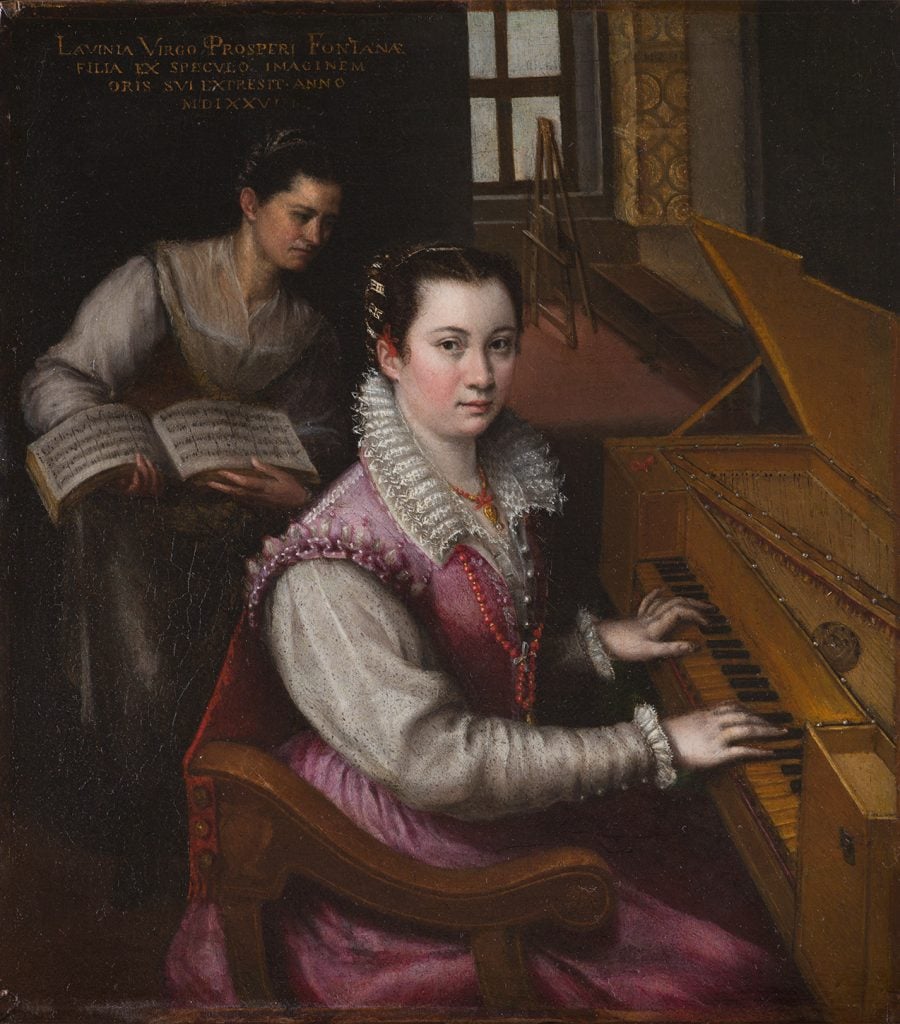
The National Gallery of Ireland is staging a rare exhibition of the trailblazing painter.

Karen Chernick

It must have taken many hands to rush the Bolognese Mannerist artist Lavinia Fontana’s most ambitious extant painting, a nearly 10-foot-long canvas from 1599, out of a burning building during the French Revolution. Smaller artworks would have been easier to salvage from the Palais Royale when revolutionaries torched it during the days of the Paris Commune, but still, someone thought to rescue Fontana’s The Visit of the Queen of Sheba to King Solomon. When it entered the collection of the National Gallery of Ireland the next year it was murky and darkened by smoke. And there it has remained for over 150 years, almost always displayed but never fully restored. Until now.
The National Gallery of Ireland has comprehensively conserved the work over the past few years, generating new insights into the practice and patrons of the painter, who was the rare Renaissance female artist to command prices equal to those of her male peers. At the base of an ornate clock held by one of the queen’s attendants in this Biblical story—which, in true Fontana fashion, is dominated by a female cast of exquisitely dressed characters—an inscription reads 1599 (a date previously unknown). And new theories have surfaced about possible real-life models for Solomon and Sheba, maybe the Duke and Duchess of Ferrara.
These discoveries, and others, have spurred the museum to organize a solo exhibition of more than 60 paintings and drawings, “Lavinia Fontana: Trailblazer, Rule Breaker,” opening May 6. It is the artist’s first major solo presentation in over 20 years.
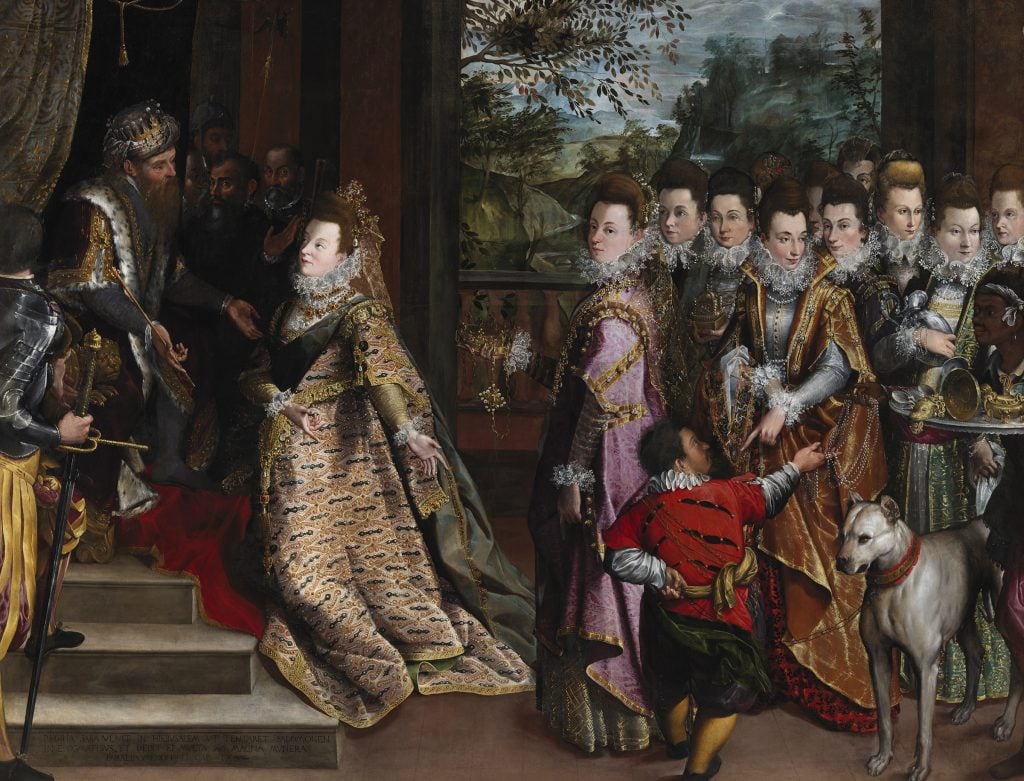
Lavinia Fontana, The Visit of the Queen of Sheba to King Solomon (1599). Image: National Gallery of Ireland.
Fontana is known mostly for her impressive life story. She was the first professional woman artist in Italy working outside a convent or court system, and fully supported her husband and children with her work (which included commissions from nobility and popes). She was also the first known woman painter to depict female nudes.
Less is known about the technical side of her work.
“We tend to be, as scholars, preoccupied by women’s biographies, which of course are fascinating when we consider the contexts in which they were working in 16th- and 17th-century Italy,” said Aoife Brady, the National Gallery of Ireland’s curator of Italian and Spanish art. “But sometimes that preoccupation comes at the expense of close looking at their artworks and defining exactly what it is that makes a Lavinia Fontana.”
Preparing around half of the artist’s oeuvre to be exhibited in the show has produced new technical data, better equipping scholars to make firm attributions to Fontana.
There isn’t a firm consensus about how many artworks Fontana produced, but around 130 extant paintings are attributable to her. Given the wave of interest in the artist over the past few years, more people are eager to pin paintings to Fontana and her attributions are “a moveable feast at the moment,” according to Brady. “We’re seeing this massive reassessment of her oeuvre.”
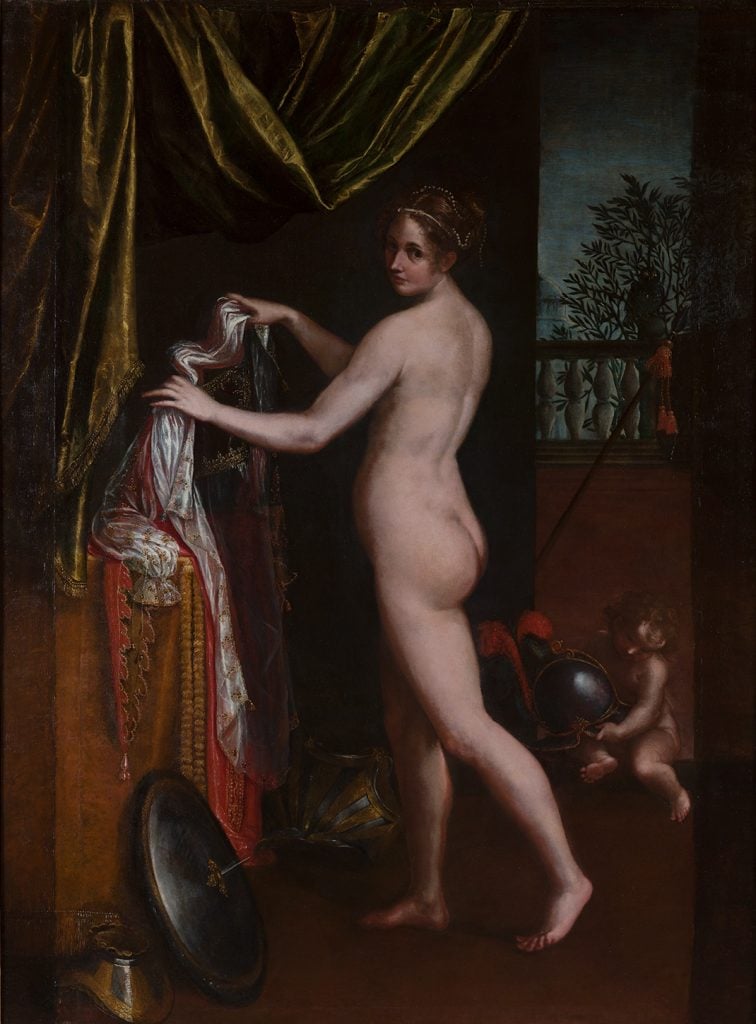
Lavinia Fontana, Minerva Dressing (1613). Courtesy of Galleria Borghese. Photo: Mauro Coen.
This comes as Fontana has recently featured in major group exhibitions at the Prado, the Wadsworth Atheneum, Detroit Institute of Arts, and Milan’s Palazzo Reale. Several Fontana works entered museum collections within the past year: The National Gallery of Art in Washington D.C. acquired Fontana’s portrait of musician Lucia Bonasoni Garzoni, for example, and the National Gallery of Victoria acquired the Mystic Marriage of St Catherine. The Getty acquired two Fontana works separately—a small painting on copper and the preparatory drawing made for it.
This swell of interest may seem sudden, but according to Babette Bohn, an art history professor at Texas Christian University and author of Women Artists, Their Patrons, and Their Publics in Early Modern Bologna, attention has come and gone for the Bolognese painter. “From my vantage point she’s always been famous,” Bohn said. “She received more biographies by early modern writers in Italy than any other woman artist during the 16th century.”
Thanks to these biographies, we know that she was born to a successful artist, Prospero Fontana, who was prominent in Bolognese society and trained her in his workshop. The future artist was born into the right family, and in the ideal location.
“Bologna as a city was a very special place, and that provided the perfect Petri dish for Fontana and her career,” explained Brady. Home to Europe’s oldest university, during Fontana’s lifetime it was ruled by an archbishop with liberal attitudes about both artists and women.
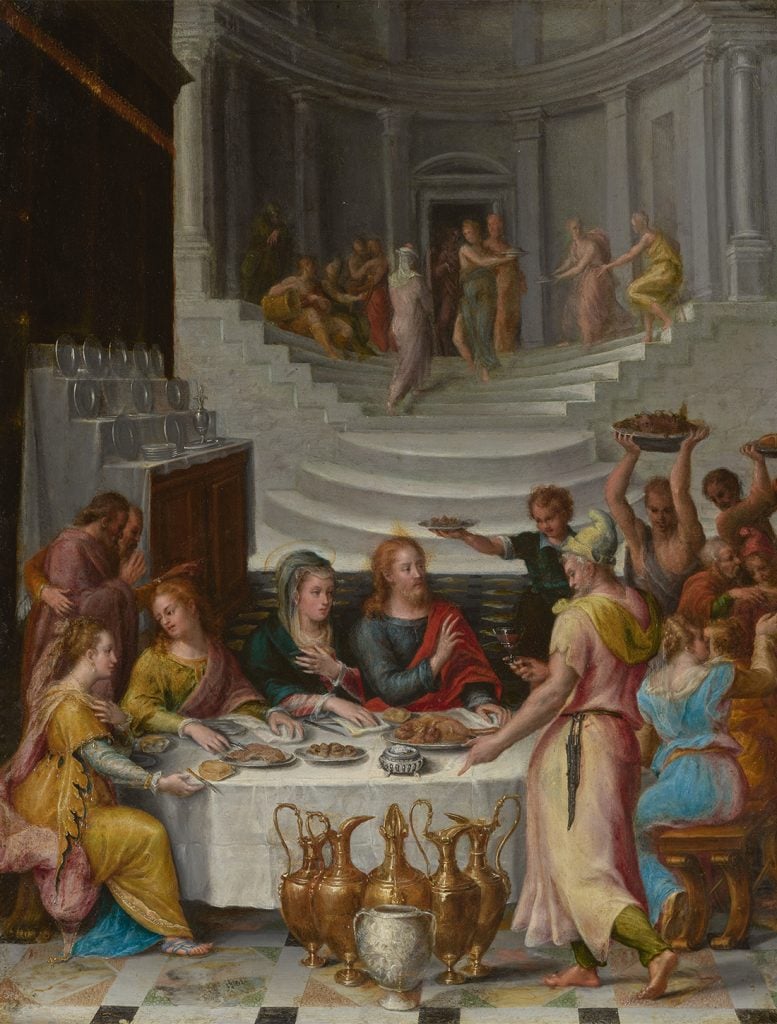
Lavinia Fontana, The Wedding Feast at Cana (c.1575-80). Courtesy of the Getty’s Open Content Program.
Bologna was one major factor, but Fontana also had a supportive family. This wasn’t a coincidence, since her father proactively found her a spouse who would support her career (and help her negotiate with clients, something decorum prevented 16th-century women from doing). She married Gian Paolo Zappi, a man with good social standing and little earning potential, and their unusual marriage contract (to be exhibited at “Lavinia Fontana: Trailblazer, Rule Breaker”) stipulated that he’d support her in pursuing a professional career.
Before their marriage was cinched, Fontana painted Self Portrait at the Spinet (1577) and sent it to Zappi’s family as a testament of her skill. This visual proof of her breadwinning abilities proved true. One of her 17th-century biographers, Carlo Cesare Malvasia, pointed out that Fontana’s fees were equal to those of Anthony Van Dyck and Justus Sustermans.
What those male contemporaries didn’t have to contend with, though, was the challenge of working while pregnant and postpartum. Fontana gave birth 11 times between 1578 and 1595, meaning she was pregnant or post-childbirth for a major part of her professional life. Most of her work during her childbearing years (and she sometimes had to return to work sooner than was medically recommended, because she was her family’s earner) was of small- or medium-scale work—more suitable for postpartum recovery. On the other hand, some of her largest works date to the late 1590s when she was no longer having children.
The smaller scale works that were Fontana’s bread and butter were her portraits of important Bolognese figures, at first men and then by the 1580s the noblewomen of the city. She painted more portraits of women than either her predecessors or successors, focusing on their strength of character and detailed rendering of their clothing and jewelry, bringing a distinctly female perspective to female subjects.
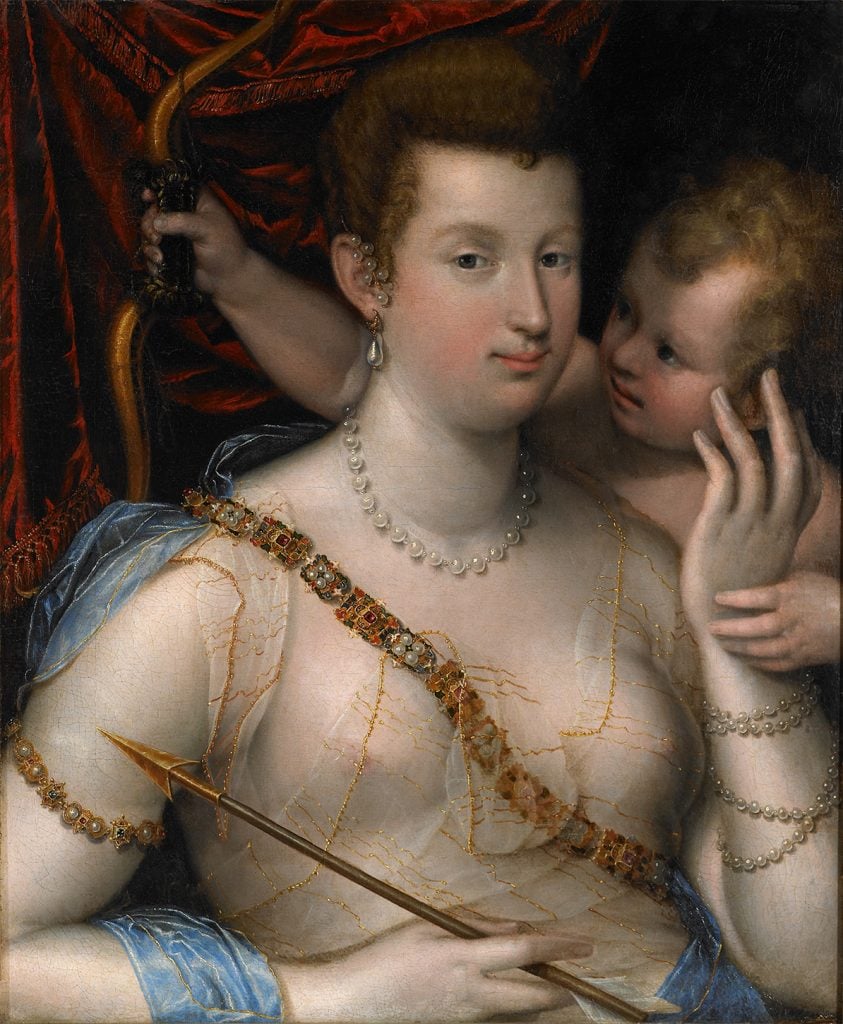
Lavinia Fontana, Venus and Cupid (1592). © Réunion des Musées Métropolitains Rouen Normandie, Musée des Beaux-Arts.
“All the ladies of the city flocked in want of her,” wrote Malvasia, “considering themselves lucky to see her in the streets, or to have meetings in the company of the virtuous young woman; there was nothing greater that they desired than to be portrayed by her.”
Fontana’s portraits of women highlight one of her most distinctive qualities—her painstakingly accurate depictions of textiles and jewelry. Written contracts survive between Fontana and her clients showing that the artist sometimes borrowed her sitters’ jewelry, to paint it as accurately as possible when sittings were no longer necessary.
This attention to detail extended to garments, too. “She has this great understanding of paint and can use it like a weaver uses thread,” said Brady. “Just by manipulating lead white pigment and using it almost like thread, she applies paint in a way that’s very intuitive and almost craftsman-like.”
In the late 1590s Fontana moved to Rome, where she was a portraitist for Pope Paul V. Also around this time she painted Vision of Saint Hyacinth (1599), the first altarpiece by a woman to be publicly displayed in Rome, and the ambitious Queen of Sheba canvas that was later rescued from a burning Palais Royale.
As scholars and audiences look closer now at Fontana’s life-sized Queen of Sheba, freshly cleaned from the smokey veil that hid the subtleties of her features all these years, a greater understanding of Fontana also comes into focus.